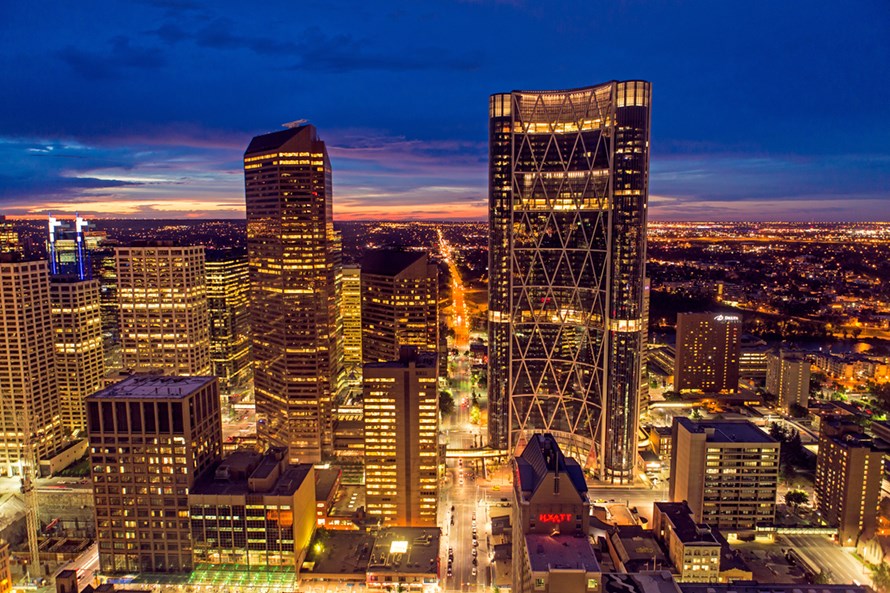Calgary’s commercial property tax rate is rising faster than any other major market in Canada, according to a new report from Altus Group.
Although annual commercial property taxes in Alberta’s biggest city sit firmly in the middle of the national pack, at $22.02 per $1,000 of assessed value, that figure is 13.3 per cent higher than in 2018.
Altus Group said in its report, “Calgary saw the largest increase in commercial tax rates for the fourth year in a row, jumping by 9.48 per cent in 2018 and again in 2019 by 13.36%. This represents an overall increase of 55 per cent in Calgary’s commercial tax rate since 2015.”
The city also saw the largest jump in another key metric, the commercial-to-residential property tax ratio. At 3.31 (meaning Calgary’s commercial tax rate is 3.31 times higher than the residential tax rate), this is a year-over-year jump of 8.31 per cent.
Altus Group added, “In the commercial-to-residential ratio has trended upwards for six consecutive years, this year experiencing the largest increase of all the regions surveyed. This is the second year in a row that Calgary has seen the largest [ratio] increase in the study.”
The primary reason for the rising mill rates and relative increase over residential tax rates is the decline in value of major office and other commercial buildings in the city, particularly in the downtown core. Decreasing assessment values are a prompt for increasing tax rates, as the city has to tax properties at a higher percentage rate to get the same operating revenues.
Phil Gertsman, executive vice-president for Western Canada at Altus Group, said in an interview, “Because of the economic situation with the oil and gas sectors, the big office buildings in Calgary’s downtown core — and there are a lot of them — have really been punished and values have plummeted. So the mill rate has to increase to generate that revenue back.”
Shifting tax burden
Gertsman added, “The problem is Calgary is that you have a shifting of the taxes, which is really burdensome for other businesses. The shift of the burden is moving away from the big office towers, towards the smaller businesses, suburban retail and industrial uses outside of the core. The values of these properties haven’t necessarily gone down, but the mill rate has increased quite a bit to make up for the big buildings in the core. It’s a bad situation, when you add that to the economic slowdown.”
Indeed, some parts of Calgary are seeing a double whammy of rising tax rates and rising assessed valued. Altus said in the report, “The city’s retail and entertainment districts, such as 17th Ave (Red Mile), Inglewood and Kensington, have been hit particularly hard. These areas have seen large increases in assessed values, partly due to demand for mixed-use residential projects and speculative investment in select sites. Sharp increases in assessments combined with a huge increase in the tax rate have caused the doubling and tripling of taxes for many of these retailers.”
The City of Calgary has attempted to offset the impact of these tax increases by offering a rebate to some businesses — but this seems only a temporary solution. Altus wrote, “Calgary city council approved a $131M rebate program to mitigate huge increases in 2019 tax bills for businesses. In the two previous years the City implemented similar one-time rebate programs to the tune of $45M each year. While these programs have been noted as effective in providing temporary relief to struggling businesses, there has been criticism that they are only a ‘band-aid’ solution to a systemic issue and have contributed to the drain of the City’s reserve funds. The temporary rebates only defer the problem and create a ‘bow wave’ effect that will see businesses faced with even larger increases the following year.”
Gertsman added, “The funding for those rebates has to come from somewhere, so they just increased the overall mill rate more than it otherwise would have been increased.”
Edmonton taxes stable
Edmonton is seeing a different story, with tax rates rising at a steady pace. Businesses in Alberta’s capital city pay $21,850 a year per $1,000 of assessed value, which is now less than Calgary and an annual increase of less than three per cent. Its commercial-to-residential tax ratio has also declined slightly this year.
Gertsman points to Edmonton’s economic diversification as a key reason for the commercial tax rate stability. “You’ve got a lot of government buildings, a lot of diverse businesses. Whereas in Calgary you’ve got more of the big energy-sector tenancies in the office buildings, so that has been hit much harder.”
Altus Group also released October 28 a separate Calgary Flash Report, which noted that commercial real estate investment sales were down 26 per cent year over year in 2019’s first half, compared with a strong early 2018.
It also said that Calgary had the biggest oversupply of office space in Canada’s major markets, with a vacancy rate of more than 20 per cent. Altus reported there is currently more than 500,000 square feet of new office space under construction in the area, of which three-quarters is not yet leased.
Read Altus Group’s commercial property tax report here, and download the Calgary Flash Report from here.



